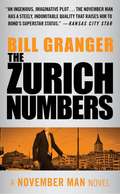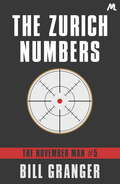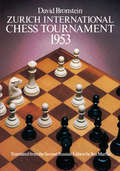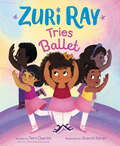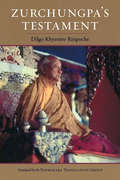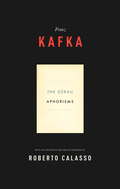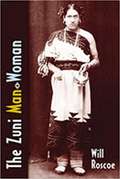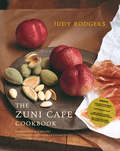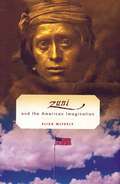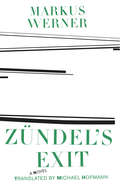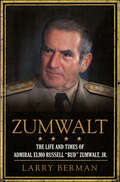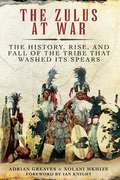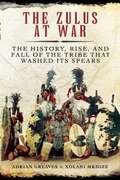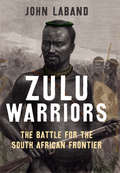- Table View
- List View
The Zurich Numbers (November Man #5)
by Bill GrangerThey are immigrants, working in American laboratories and universities. They are Soviet spies, forced into a network of terror, with their families dangling as hostages. When Devereaux--the November Man--uncovers the brutal scheme, the forces of both East and West mark him and the woman he loves for death. From California to Chicago to Switzerland, the November Man tracks the cold-blooded mastermind who controls the numbers. In a vicious maze of power, murder, and greed, every enemy may be a friend--and every friend, a sudden traitor.
The Zurich Numbers: The November Man Book 5 (The November Man #5)
by Bill GrangerWARNING: ADDICTIVE READING.WE WILL NOT BE HELD RESPONSIBLE FOR LOSS OF TIME, DRY EYES OR DISCONNECTION WITH REALITY FOLLOWING PROLONGED READING.'Granger has combined Ian Fleming, John Le Carré and Trevanian in one heady mix' New York TimesSTART READING THE NOVEMBER MAN SERIES NOW! Then go on to read the rest, you won't regret it.Devereaux has lived on the edge for long enough to know trouble when it comes his way. He has been out of action for a year, but he is still a target. The Opposition won't forget the November Man and won't make the same mistakes again. Even R Section can't offer him much protection but, as Devereaux said himself, all the king's horses and all the king's men won't stop the Russians getting what they want. So with a KGB issued contract on his life drawing Soviet hitmen onto US soil, Devereaux is out on his own. Precisely where he wants to be...'America's best spy novelist' - Ed McBainLoved this? Read Hemingway's Notebook next . . .
Zurich International Chess Tournament, 1953
by David BronsteinThe book of a strong tournament is more than just a games collection. When its participants are the world's strongest players . . . the tournament as a whole represents a step forward in the development of chess creativity. We may take as examples of such tournaments the events at Hastings 1895, St. Petersburg 1914, New York 1924, Moscow 1935, and Groningen 1946. Beyond doubt, Zurich-Neuhausen 1953 deserves a place among them.David Bronstein ventured this evaluation of Zurich 1953 just three years after the event, in the preface to the first Russian edition of this book. Since that time the 210 games of the legendary tournament have only grown in stature. Most knowledgeable chess players now rate it the greatest tournament since World War II, and possibly the greatest tournament of all time.In the 1920s Jim Marfia, a talented amateur player, became determined to provide an authoritative English translation of Bronstein's book, a task which occupied him for several years. The complete record of the famous Zurich International Chess Tournament, 1953, is available in English for the first time.Held to determine a challenger for then World Champion Botvinnik, Zurich 1953 attracted fifteen of the strongest players in the world: Smyslov; Geller; Boleslavsky; Bronstein; Najdorf; Szabo; Keres; Kotov; Gligoric; Reshevsky; Taimanov; Euwe; Petrosian; Averbakh; and Stahlberg.Almost all the games were hotly contested, and many are masterpieces of the first rank. To mention Euwe-Smylov (round 3), Taimanov-Najdorf (round 4, winner of a brilliancy prize), and Keres-Reshevsky (round 11, one of the most reproduced and analyzed games in chess), is just to touch the tip of the iceberg; there are literally dozens of memorable, innovative games in this volume, including a substantial portion by the author, one of the game's greatest players, who finished tied for second with Keres and Reshevsky, behind the winner Smyslov.Advanced players will want this book for the games alone. Beginning and intermediate players, concerned more immediately with instruction, will find David Bronstein's annotations not only perceptive and thorough, but also a veritable textbook on how to play the middle game.
Zurich Insurance: Fostering People Management Practices
by Boris Groysberg Katherine ConnollyZurich Insurance was undergoing organizational change after implementing five new people practices focused on: manager development, diversity and inclusion, job model and data analytics, recruitment, and talent pipeline. The case provides background of the company, as well as a description of how its culture was changing and how its allocation of resources was being examined as it tried to improve its position in the marketplace. Students are asked to prioritize which people practices are most important for Zurich as it tries to shift its culture and more effectively leverage its human capital in order to reach its organizational goals.
Zurich Insurance: Fostering People Management Practices
by Katherine Connolly Boris GroysbergZurich Insurance was undergoing organizational change after implementing five new people practices focused on: manager development, diversity and inclusion, job model and data analytics, recruitment, and talent pipeline. The case provides background of the company, as well as a description of how its culture was changing and how its allocation of resources was being examined as it tried to improve its position in the marketplace. Students are asked to prioritize which people practices are most important for Zurich as it tries to shift its culture and more effectively leverage its human capital in order to reach its organizational goals.
Zurich Insurance: Diversity and Inclusion
by Katherine Connolly Boris GroysbergZurich Insurance was undergoing organizational change after implementing five new people practices focused on: manager development, diversity and inclusion, job model and data analytics, recruitment, and talent pipeline. The case "Zurich Insurance: Fostering Key People Management Practices" (417-035) provides background of the company and an outline of each people practice, as well as a description of how the company's culture was changing and how its allocation of resources was being examined as it tried to improve its position in the marketplace. This case takes a closer look at the company's efforts around diversity and inclusion.
Zurich Insurance: Global Job Structure and Data Analysis
by Katherine Connolly Boris GroysbergZurich Insurance was undergoing organizational change after implementing five new people practices focused on: manager development, diversity and inclusion, job model and data analytics, recruitment, and talent pipeline. The case "Zurich Insurance: Fostering Key People Management Practices" (417-035) provides background of the company and an outline of each people practice, as well as a description of how the company's culture was changing and how its allocation of resources was being examined as it tried to improve its position in the marketplace. This case takes a closer look at the implementation of a global job model and how it has enabled the use of data analytics in the human resources function.
Zurich Insurance: Recruitment
by Katherine Connolly Boris GroysbergZurich Insurance was undergoing organizational change after implementing five new people practices focused on: manager development, diversity and inclusion, job model and data analytics, recruitment, and talent pipeline. The case "Zurich Insurance: Fostering Key People Management Practices" (417-035) provides background of the company and an outline of each people practice, as well as a description of how the company's culture was changing and how its allocation of resources was being examined as it tried to improve its position in the marketplace. This case takes a closer look at the adoption of new recruitment practices.
Zurich Insurance: Talent Pipeline
by Katherine Connolly Boris GroysbergZurich Insurance was undergoing organizational change after implementing five new people practices focused on: manager development, diversity and inclusion, job model and data analytics, recruitment, and talent pipeline. The case "Zurich Insurance: Fostering Key People Management Practices" (417-035) provides background of the company and an outline of each people practice, as well as a description of how the company's culture was changing and how its allocation of resources was being examined as it tried to improve its position in the marketplace. This case takes a closer look at succession planning at the top of the organization, including a focus on leadership competencies and development.
Zurich Insurance: Fostering Key People Management Practices
by Boris Groysberg Katherine ConnollyZurich Insurance was undergoing organizational change after implementing five new people practices focused on: manager development, diversity and inclusion, job model and data analytics, recruitment, and talent pipeline. The case provides background of the company, as well as a description of how its culture was changing and how its allocation of resources was being examined as it tried to improve its position in the marketplace. Students are asked to prioritize which people practices are most important for Zurich as it tries to shift its culture and more effectively leverage its human capital in order to reach its organizational goals.
Zurich Insurance: Zurich Oxygen
by Boris Groysberg Katherine ConnollyZurich Insurance was undergoing organizational change after implementing five new people practices focused on: manager development, diversity and inclusion, job model and data analytics, recruitment, and talent pipeline. The case "Zurich Insurance: Fostering Key People Management Practices" (417-035) provides background of the company and an outline of each people practice, as well as a description of how the company's culture was changing and how its allocation of resources was being examined as it tried to improve its position in the marketplace. This case takes a closer look at the implementation of the manager development initiative "Zurich Oxygen."
Zuri Ray Tries Ballet
by Tami CharlesFrom New York Times bestselling author Tami Charles and rising star illustrator Sharon Sordo comes the first book in a charming picture book series about a fun, spunky girl with a huge heart! Meet Zuri Ray. She’s always willing to go the extra mile for family and friends and is up for any challenge. At least, that was before her best friend, Jessie, asked her to join a ballet camp. Now Zuri isn’t sure if she’s up for everything. While Jessie can’t wait to chassé and plié while wearing tight hair buns and frilly tutus, that doesn’t sound like Zuri at all! But she can’t let her friend down. Maybe classical ballet just needs a new spin . . . Perfect for fans of Fancy Nancy and Fresh Princess, Zuri Ray Tries Ballet encourages kids to follow their hearts and stay true to themselves!
Zurchungpa's Testament: Zurchungpa's Testament; A Wondrous Ocean Of Advice For The Practice Of Retreat In Solitude; Pure Appearance; Primordial Purity; The Lamp That Dispels Darkness (The\collected Works Of Dilgo Khyentse Ser. #3)
by Dilgo KhyentseZurchungpa's Eighty Chapters of Personal Advice was the final teaching given by the great Nyingma master Zurchung Sherab Trakpa before he passed away. His counsels are the distillation of a lifetime's experience and comprise the practical instructions of a master who had made the teachings of the Great Perfection truly part of himself. The original text consists of almost 580 maxims, organized into eighty chapters covering the entire path of Dzogchen, from fundamental teachings on devotion and renunciation, through to a whole series of pith instructions that bring the Dzogchen view to life. Much of the meaning of these pithy, often cryptic, instructions could be lost on the reader without the help of the notes Shechen Gyaltsap Rinpoche provided in his annotated edition, which he based on the explanations he received from his own teacher, Jamyang Khyentse Wangpo. This book contains a complete detailed teaching on Zurchungpa's text by Dilgo Khyentse Rinpoche, based on Shechen Gyaltsap's notes. Originally intended as essential instructions for a group of practitioners in three-year retreat, it will undoubtedly serve as an indispensable guide to anyone who seriously wishes to practice the Great Perfection. Zurchung Sherab Trakpa (1014-1074) was a key teacher in the Zur tradition, one of the handful of kama lineages through which the teachings of the Ancient Tradition were transmitted from master to disciple, beginning with Guru Padmasambhava and Vimalamitra, right down to the Nyingma masters of the present day. He was a learned scholar and accomplished meditation master who spent many years in retreat, practicing the teachings of the Great Perfection. Shechen Gyaltsap Rinpoche (1871-1926) was an important disciple of Jamyang Khyentse Wangpo the Great and one of Dilgo Khyentse Rinpoche's root teachers. An accomplished meditator, he was also one of the most respected scholars of his day, whose writings fill thirteen volumes.
The Zurau Aphorisms of Franz Kafka
by Franz KafkaThe essential philosophical writings of one of the twentieth century's most influential writers are now gathered into a single volume with an introduction and afterword by the celebrated writer and publisher Roberto Calasso. Illness set him free to write a series of philosophical fragments: some narratives, some single images, some parables. These "aphorisms" appeared, sometimes with a few words changed, in other writings--some of them as posthumous fragments published only after Kafka's death in 1924. While working on K., his major book on Kafka, in the Bodleian Library, Roberto Calasso realized that the Zürau aphorisms, each written on a separate slip of very thin paper, numbered but unbound, represented something unique in Kafka's opus--a work whose form he had created simultaneously with its content.The notebooks, freshly translated and laid out as Kafka had intended, are a distillation of Kafka at his most powerful and enigmatic. This lost jewel provides the reader with a fresh perspective on the collective work of a genius.
The Zuni Man-Woman
by Will RoscoeThe Zuni Man-Woman focuses on the life of We'wha (1849-96), the Zuni who was perhaps the most famous berdachein American Indian history. Through We'wha's exceptional life, Will Roscoe creates a vivid picture of an alternative gender role whose history has been hidden and almost forgotten.
The Zuni Cafe Cookbook: A Compendium of Recipes and Cooking Lessons from San Francisco's Beloved Restaurant
by Gerald Asher Judy RodgersFor twenty-four years, in an odd and intimate warren of rooms, San Franciscans of every variety have come to the Zuni Café with high expectations and have rarely left disappointed. <P><P>In The Zuni Café Cookbook, a book customers have been anticipating for years, chef and owner Judy Rodgers provides recipes for Zuni's most well-known dishes, ranging from the Zuni Roast Chicken to the Espresso Granita. But Zuni's appeal goes beyond recipes. Harold McGee concludes, "What makes The Zuni Café Cookbook a real treasure is the voice of Zuni's Judy Rodgers," whose book "repeatedly sheds a fresh and revealing light on ingredients and dishes, and even on the nature of cooking itself." Deborah Madison (Vegetarian Cooking for Everyone) says the introduction alone "should be required reading for every person who might cook something someday."
The Zuni and the American Imagination
by Eliza McfeelyA bold new study of the Zuni, of the first anthropologists who studied them, and of the effect of Zuni on America's sense of itselfThe Zuni society existed for centuries before there was a United States, and it still exists in its desert pueblo in what is now New Mexico. In the late nineteenth century, anthropologists-among the first in this new discipline-came to Zuni to study it and, they believed, to salvage what they could of its tangible culture before it was destroyed, which they were sure would happen. Matilda Stevenson, Frank Hamilton Cushing, and Stewart Culin were the three most important of these early students of Zuni, and although modern anthropologists often disparage and ignore their work-sometimes for good, sometimes for poor reasons-these pioneers gave us an idea of the power and significance of Zuni life that has endured into our time. They did not expect the Zuni themselves to endure, but they have, and the complex relation between the Zuni as they were and are and the Zuni as imagined by these three Easterners is at the heart of Eliza McFeely's important new book.Stevenson, Cushing, and Culin are themselves remarkable subjects, not just as anthropology's earliest pioneers but as striking personalities in their own right, and McFeely gives ample consideration, in her colorful and absorbing study, to each of them. For different reasons, all three found professional and psychological satisfaction in leaving the East for the West, in submerging themselves in an alien and little-known world, and in bringing back to the nation's new museums and exhibit halls literally thousands of Zuni artifacts. Their doctrines about social development, their notions of "salvage anthropology," their cultural biases and predispositions are now regarded with considerable skepticism, but nonetheless their work imprinted Zuni on the American imagination in ways we have yet to measure. It is the great merit of McFeely's fascinating work that she puts their intellectual and personal adventures into a just and measured perspective; she enlightens us about America, about Zuni, and about how we understand each other.
Zundel's Exit
by Michael Hoffman Markus WernerScrounged from his notebooks and hearsay, this is the story of a schoolteacher named Konrad Zündel: a philosopher, a wanna-be writer; scattered, self-conscious, glum, anxious, unlucky, discontent . . . At the end of his rope, he decides to flee his workaday life at all costs, only to find escape always a little beyond his reach. First his tooth falls out in the sight of other travelers, then he finds a severed finger in a restroom on a train. In fact, Zündel seems on the verge of falling to bits, as do his words, thoughts, wife, and world--will there be anything left, and anyone to hold the pieces? Zündel's Exit is a Chaplinesque comedy of disintegration, never knowing if it's coming or going.
Zundel's Exit
by Markus Werner Michael HoffmanScrounged from his notebooks and hearsay, this is the story of a schoolteacher named Konrad Zündel: a philosopher, a wanna-be writer; scattered, self-conscious, glum, anxious, unlucky, discontent . . . At the end of his rope, he decides to flee his workaday life at all costs, only to find escape always a little beyond his reach. First his tooth falls out in the sight of other travelers, then he finds a severed finger in a restroom on a train. In fact, Zündel seems on the verge of falling to bits, as do his words, thoughts, wife, and world--will there be anything left, and anyone to hold the pieces? Zündel's Exit is a Chaplinesque comedy of disintegration, never knowing if it's coming or going.
Zumwalt: The Life and Times of Admiral Elmo Russell "Bud" Zumwalt, Jr.
by Larry BermanAdmiral Elmo Russell Zumwalt, Jr., the charismatic chief of naval operations (CNO) and "the navy's most popular leader since WWII" (Time), was a man who embodied honor, courage, and commitment. In a career spanning forty years, he rose to the top echelon of the U.S. Navy as a commander of all navy forces in Vietnam and then as CNO from 1970 to 1974. His tenure came at a time of scandal and tumult, from the Soviets' challenge to the U.S. for naval supremacy and a duplicitous endgame in Vietnam to Watergate and an admirals' spy ring.Unlike many other senior naval officers, Zumwalt successfully enacted radical change, including the integration of the most racist branch of the military—an achievement that made him the target of bitter personal recriminations. His fight to modernize a technologically obsolete fleet pitted him against such formidable adversaries as Henry Kissinger and Hyman Rickover. Ultimately, Zumwalt created a more egalitarian navy as well as a smaller modernized fleet better prepared to cope with a changing world.But Zumwalt's professional success was marred by personal loss, including the unwitting role he played in his son's death from Agent Orange. Retiring from the service in 1974, Zumwalt spearheaded a citizen education and mobilization effort that helped thousands of Vietnam veterans secure reparations. That activism earned him the nation's highest civilian honor, the Presidential Medal of Freedom. Today Zumwalt's tombstone at the U.S. Naval Academy is inscribed with one word: "Reformer." Admiring yet evenhanded, Larry Berman's moving biography reminds us what leadership is and pays tribute to a man whose life reflected the best of America itself.
ZUMBERGE'S LABORATORY MANUAL FOR Physical Geology
by James Zumberge Robert H. Rutford James L. CarterLaboratory Manual for Physical Geology, 14e is written for the freshman-level laboratory course in physical geology. In this lab, students study Earth materials, geologic interpretation of topographic maps, aerial photographs and Earth satellite imagery, structural geology and plate tectonics and related phenomena. With over 30 exercises, professors have great flexibility when developing the syllabus for their physical geology lab course.
Zumarraga and the Mexican Inquisition, 1536-1543
by Richard E. GreenleafThe purpose of this study is to investigate the inquisitorial activities of Don Fray Juan de Zumárraga, first Bishop and Archbishop of Mexico, 1528-1548. Zumárraga served as Apostolic Inquisitor in the bishopric of Mexico from 1536 to 1542, when he was superseded in that office by the Visitor General, Francisco Tello de Sandoval, largely because he had relaxed Don Carlos, the cacique of Texcoco, to the secular arm for burning, an act regarded as rash by the authorities in Spain.Throughout this essay an attempt is made to relate the Inquisition to the political and intellectual life of early sixteenth-century Mexico. Zumárraga is pictured as the defender of orthodoxy and the stabilizer of the spiritual conquest in Mexico. The relationship of the individual and of society collectively with the Holy Office of the Inquisition is stressed.With the exception of background materials, this study is based entirely upon primary sources, trial records which for the most part have lain unstudied since the sixteenth century. In all, two years of research in the Ramo de la Inquisición of the Archivo General de la Nación in Mexico City were consumed in ferreting out these materials. Subsidiary investigations in other sections of the Mexican archives were made in order to place the Inquisition materials in their proper perspective.—Richard E. Greenleaf
The Zulus at War: The History, Rise, and Fall of the Tribe That Washed Its Spears
by Adrian Greaves Xolani MkhizeBy tracing the long and turbulent history of the Zulus from their arrival in South Africa and the establishment of Zululand, The Zulus at War is an important and readable addition to this popular subject area. It describes the violent rise of King Shaka and his colorful successors under whose leadership the warrior nation built a fearsome fighting reputation without equal among the native tribes of South Africa. It also examines the tactics and weapons employed during the numerous intertribal battles over this period. They then became victims of their own success in that their defeat of the Boers in 1877 and 1878 in the Sekunini War prompted the well-documented British intervention. Initially the might of the British empire was humbled as never before by the shock Zulu victory at Isandlwana but the 1879 war ended with the brutal crushing of the Zulu Nation. But, as Adrian Greaves reveals, this was by no means the end of the story. The little known consequences of the division of Zululand, the Boer War, and the 1906 Zulu Rebellion are analyzed in fascinating detail. An added attraction for readers is that this long-awaited history is written not just by a leading authority but, thanks to the coauthor’s contribution, from the Zulu perspective using much completely fresh material.Skyhorse Publishing, as well as our Arcade imprint, are proud to publish a broad range of books for readers interested in history--books about World War II, the Third Reich, Hitler and his henchmen, the JFK assassination, conspiracies, the American Civil War, the American Revolution, gladiators, Vikings, ancient Rome, medieval times, the old West, and much more. While not every title we publish becomes a New York Times bestseller or a national bestseller, we are committed to books on subjects that are sometimes overlooked and to authors whose work might not otherwise find a home.
The Zulus at War: The History, Rise, and Fall of the Tribe That Washed Its Spears
by Adrian Greaves Xolani MkhizeBy tracing the long and turbulent history of the Zulus from their arrival in South Africa and the establishment of Zululand, The Zulus at War is an important and readable addition to this popular subject area. It describes the violent rise of King Shaka and his colorful successors under whose leadership the warrior nation built a fearsome fighting reputation without equal among the native tribes of South Africa. It also examines the tactics and weapons employed during the numerous intertribal battles over this period. They then became victims of their own success in that their defeat of the Boers in 1877 and 1878 in the Sekhukhuni War prompted the well-documented British intervention.Initially the might of the British Empire was humbled as never before by the surprising Zulu victory at Isandlwana but the 1879 war ended with the brutal crushing of the Zulu nation. But, as Adrian Greaves reveals, this was by no means the end of the story. The little known consequences of the division of Zululand, the Boer War, and the 1906 Zulu Rebellion are analyzed in fascinating detail. An added attraction for readers is that this long-awaited history is written not just by a leading authority but also, thanks to the coauthor's contribution, from the Zulu perspective using much completely fresh material.
Zulu Warriors:The Battle for the South African Frontier
by John LabandToward the end of the nineteenth century, the British embarked on a concerted series of campaigns in South Africa. Within three years they waged five wars against African states with the intent of destroying their military might and political independence and unifying southern Africa under imperial control. This is the first work to tell the story of this cluster of conflicts as a single whole and to narrate the experiences of the militarily outmatched African societies.<P> Deftly fusing the widely differing European and African perspectives on events, John Laband details the fateful decisions of individual leaders and generals and explores why many Africans chose to join the British and colonial forces. The Xhosa, Zulu, and other African military cultures are brought to vivid life, showing how varying notions of warrior honor and manliness influenced the outcomes for African fighting men and their societies.
